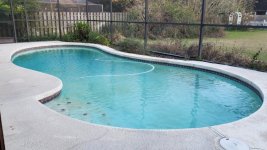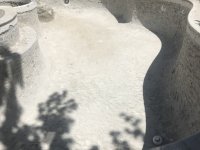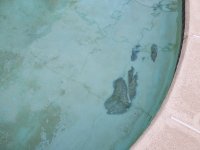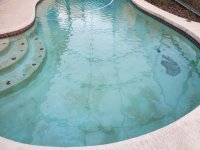We have a medium size (15k gallons) inground gunite pool that was built in 1992, so about 30 years old. Never been resurfaced. The marcite started to show signs of erosion probably 10 years ago but in recent years it’s gotten worse. We now have major discoloration on the steps, bottom and walls, as well as black patches in the bottom (I think it’s the gunite showing through). Anyway, we really need to resurface, and thinking of doing it in the next month or so (before the rainy season). Nothing fancy in this pool - no spa, no sun ledge, no waterfalls, just a standard pool that came with the house when we bought it.
We’re torn on which surface to get. We really like the look of the white marcite, but I’ve read that modern-day plaster doesn’t last very long, so we’re also looking into quartz and pebble but not sure which one to get. Obviously cost is a concern, but apart from that, the look we’re looking for is: white or close to it (no colors or speckled/mottled stuff), smooth (flat/no texture), and matte (no shiny stuff). We’d also like something that lasts a while since we have no plans to move anytime soon. Some options I saw were DiamondBrite (in ‘oyster’), Quartzscapes (in ‘ivory’), PebbleFina (in ‘classico’), and of course plan B - regular white marcite. Any thoughts to help me decide? Are any of these textured and/or really shiny? Do any of them take longer to install? I’m in Florida if that helps, and the waterline tile and deck are good so not going to redo those, which should keep the cost down.

We’re torn on which surface to get. We really like the look of the white marcite, but I’ve read that modern-day plaster doesn’t last very long, so we’re also looking into quartz and pebble but not sure which one to get. Obviously cost is a concern, but apart from that, the look we’re looking for is: white or close to it (no colors or speckled/mottled stuff), smooth (flat/no texture), and matte (no shiny stuff). We’d also like something that lasts a while since we have no plans to move anytime soon. Some options I saw were DiamondBrite (in ‘oyster’), Quartzscapes (in ‘ivory’), PebbleFina (in ‘classico’), and of course plan B - regular white marcite. Any thoughts to help me decide? Are any of these textured and/or really shiny? Do any of them take longer to install? I’m in Florida if that helps, and the waterline tile and deck are good so not going to redo those, which should keep the cost down.






